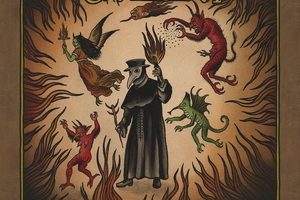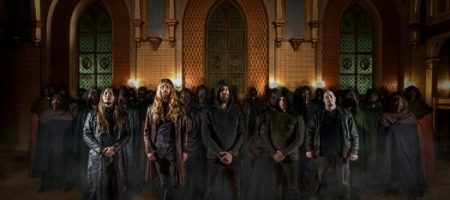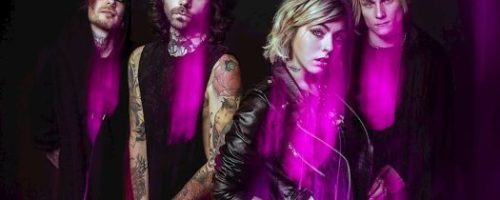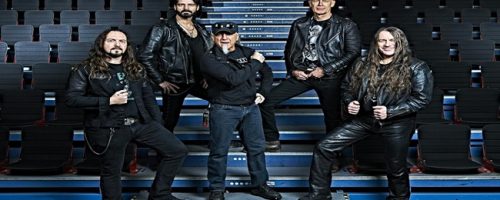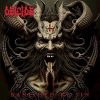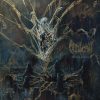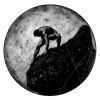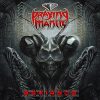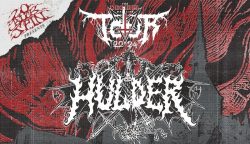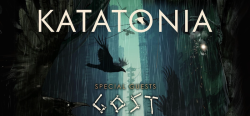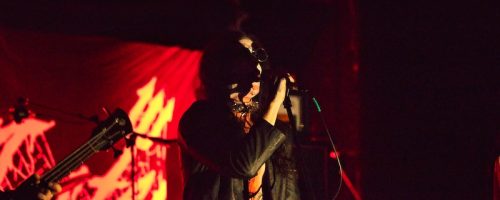Apocalypse Orchestra – Bringing Doom Back to the Dark Ages
Wednesday, 28th June 2017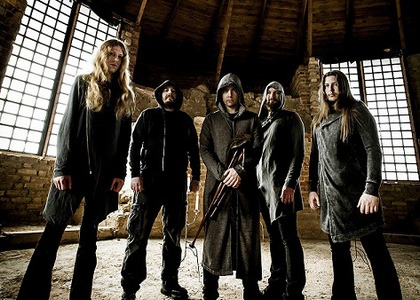
In a time where speed and rushing to get things done are becoming more and more of a priority, it’s nice to see a new band emerge that embraces a slower pace. Sweden’s Apocalypse Orchestra combine traditional folk instrumentation with plenty of doom, alongside a medieval feel. Individually, all of these components have seen their time in metal before, but Apocalypse Orchestra gives them a fresh spin that brings a fresh feeling to the new act.
The band’s first effort, The End is Nigh, was recently released through Despotz Records. Their combination of the aforementioned elements piqued DR’s interest so we reached out to bagpipe and hurdy gurdy player Mikael Lindstrom, who was able to tackle our request for more information about the band, medieval instruments, and more.
Dead Rhetoric: As a newer act, could you give us a brief history of how the band came to be?
Mikael Lindstrom: Erik and I have played together for a long time and when our last band went belly up we got the idea to start something new. Since both of us love folk music, medieval music and metal we decided to combine everything into something we felt the world of metal was missing.
We spent about six months writing and arranging songs. We had agreed to let things take their time, not to rush anything. The local newspaper announced that they were going to have a competition where the winner got to play with our towns symphonic orchestra. We applied and realized that we would need a full band so we recruited long time friends Jonas, Rikard and Andreas. We ultimately won the competition and everything started to accelerate from there.
Dead Rhetoric: What do you feel best describes the sound of Apocalypse Orchestra?
Lindstrom: In a review someone called it Contemporary Medieval Metal and that fits rather well. But if you want to delve deeper perhaps medieval inspired doom flavoured modern sounding metal with a hint of progressiveness explains it a bit further.
Dead Rhetoric: Who are some of the band’s bigger influences in putting your sound together?
Lindstrom: I personally get a lot of inspiration from medieval instrumental music and ballads alongside some Swedish folk music. For the metal part, we’re all fans of Type O Negative, Opeth and Amorphis. We’re also influenced by artists such as Hieronymus Bosch, Pieter Bruegel and Albrecht Dürer as well as historical oddities such as the plague doctors and the flagellant movement.
Dead Rhetoric: How’d you come to sign with Despotz Records?
Lindstrom: About one year ago Despotz Records contacted us and we signed the record deal a few weeks later. They’re an easygoing bunch with total respect for the creative process, always letting us do our thing and never interfering in any way. We’re very happy with how things turned out and could not wish for a more supportive and understanding label.
Dead Rhetoric: Could you shed some light on some of the finer details of the cover art?
Lindstrom: The beauty (?) is in the eye of the beholder. We’ve heard several interpretations of it and that’s what we were trying to achieve. It’s quite ambiguous, did the plague doctor in the center actually cure anyone or did he help spreading the decease further? Feel free to contact us with your own view of it!
It is painted by Cezilia Hjelt, a Swedish tattoo artist with a unique style which encapsulates both the medieval harshness as well as weirdness often found in historical art.
Dead Rhetoric: In an age where most tend to play faster and faster, is there something to be said for choosing to play at slower, doomier speeds?
Lindstrom: It fits the theme of our band. The everyday toil of little man during the dark ages must have been tremendous, the hardships of losing several of your children, the fear of ever present death and at the same time feeling the pressure from the church to be a devout follower so you don’t end up in hell. The heaviness of the music accentuates the mood we’re trying to bring forth. Also, many of the medieval melodies we incorporate in our songs sounds best when played in a slower pace.
That being said, we’ve never said that we’ll always play slow, there almost certainly will be faster songs in the future.
Dead Rhetoric: Anything you can say about the video for “The Garden of Earthly Delights?”
Lindstrom: We knew from the start that we didn’t want a classic metal video with fast cuts, shaky cams and flashing imagery. That just doesn’t suit us. Since the song is so long it would be a problem to keep the viewers interested but in the end it turned out better than we’ve could have hoped. Much thanks to Magnus Ewald who did all the directing, camera work and editing. We were lucky enough to get to film at Vasaborgen in Uppsala in Sweden, a 14th century castle ruin. Again, we were aiming for ambiguity, to keep it open for personal interpretation. Who is the man in the video and what is his goals? We didn’t want to have an obvious story line, rather an open flow of imagery that accompanied the music.
The man with the white hair and nose ring is a local artist called Christer Linde and he was a delight to work with. Since the video was a huge success (almost 400000 views now) we will be making more of them.
Dead Rhetoric: In terms of the medieval/folk instruments that you placed into The End is Nigh, are you particularly happy to have been able to use a particular instrument?
Lindstrom: It was very fun to play the Rauschpfeife! We didn’t know if we were going to use it at all but we found a place in the song To Embark where it fitted nicely. Rauschpfeife could be translated into Noise Pipe, which is a very suiting name since it sounds VERY loud and sharp. If you hate your neighbours you should buy one!
Dead Rhetoric: Are there any medieval instruments that you’d like to include for future releases?
Lindstrom: Oh yes! The hammered dulcimer is a very beautiful sounding instrument that we like. And it would be really cool to be able to incorporate a portative organ, which is an organ small enough to have in your lap, pressing the keys with one hand while pumping the bellow with the other. And I really love the sound of crumhorns!
The trouble with many of those instruments is that they are very expensive…
Dead Rhetoric: What is it about medieval times that works so well with heavy metal?
Lindstrom: The lyrical themes of metal music is often about death and darkness and the medieval times had a lot of that…
All jokes aside, many of the metal fans we know have an interest in history, be it reenactment, LARPing or just reading. Perhaps it’s about escapism, being transported to another time and place through music.
Dead Rhetoric: Is there much opportunity for Apocalypse Orchestra to play in the live setting? What’s a live show like?
Lindstrom: Not as often as we would like but now when the album is out hopefully we’ll get to play more! Just as our music we try to make our shows as multifaceted as possible. We want it to be an experience that is more than just the music so if the venue allows it there will be fire breather, dancers, animations tailored to each song, candles and the like. To quote a certain Swedish guitarist, “More is more!”.
Dead Rhetoric: What’s on the agenda for Apocalypse Orchestra as we continue to march through 2017?
Lindstrom: More live shows and new videos to begin with then start composing for the next album. We want our music to spread like the black death in 1349!
Apocalypse Orchestra on Facebook











